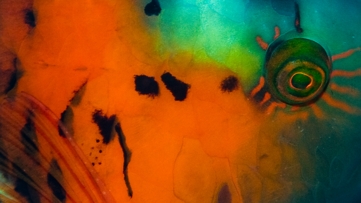
| Home |
| Colors of the Reef |
| Search the Reef |
| Science and the Reef |
| Equipment |
| New |
| Links |
| Contact |
| Interna |
Colors in Water and why is Water Blue?
The colors we see when diving or snorkeling in a coral reef are the results of absorption, refraction, and reflection of the ambient light, which is basically what is left over from the sunlight in a given depths of water. In rare cases, when there is no ambient light (night dives) we can see emissions from organisms, either as fluorescence (which is a conversion of ultraviolet or blue light into longer wavelengths, which is the yellow to red region of the spectrum) or as bioluminescence (which is chemiluminescence produced in an organism).
In this case organisms produce light by energetic chemical processes. This produces the glow of the ocean in night dives or the light emissions of various organisms seen in the dark. These are the major natural sources of light in the ocean: the light of the sun penetrating the water and getting weaker with every meter and the weak bioluminescence which can only compete with the sun at great depths or during the night.
Thick layers of even the purest water look blue because water absorbs all other colors - especially red - better than blue, which means, thick layers of water appear blue to the eye. Thus, the water itself is colored! This absorption is very weak und results from the tailing of a vibrational overtone around 760 nm. Almost all dyes are colored because of electronic transitions induced by the absorption of photons. This is different with water: here, vibrations are excited and not electrons. This has an interesting consequence. The heavy isotopomer of water containing deuterium instead of hydrogen D2O has its vibrations shifted further to the red, and thus thick layers of D2O don't appear to be blue (you can see the experiment here).
This explains why the water of oceans, lakes, and even swimming pools is blue as long as it is clean. Green, brown and other colors come from algae or dirt particles and are not related directly to the water. The sky is also blue - but for different reasons. The molecules of the air scatter light, blue more than red, but don't absorb.


